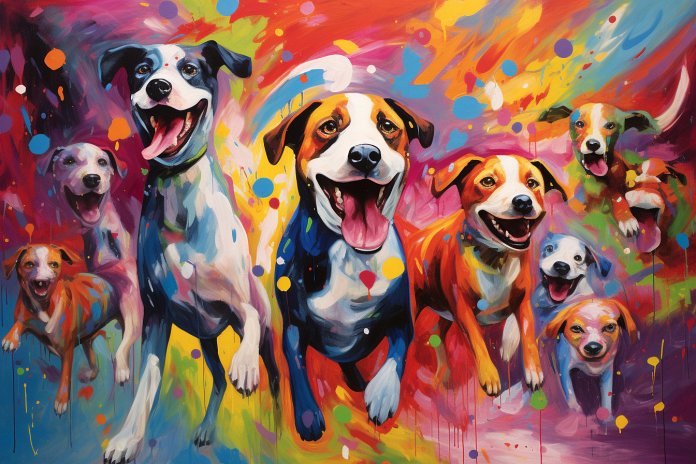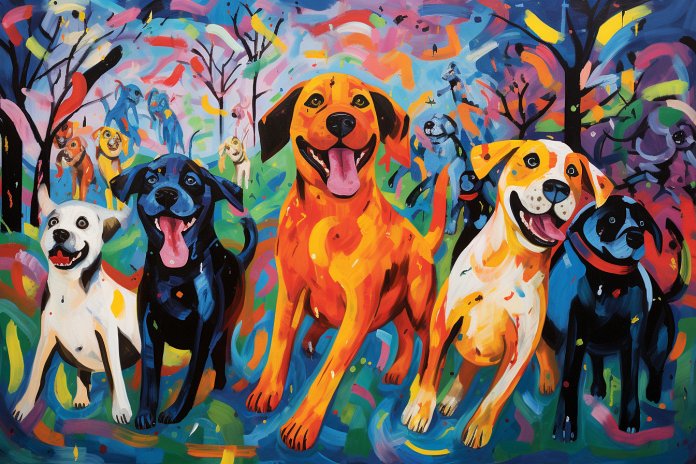
You might think you already know the answer to the question “Can dogs be color blind?” However, what if we told you that everything you’ve been led to believe about your dog’s sight is wrong?
Surprising to most people, dogs don’t only see in black and white as commonly believed. In reality, dogs see a limited color spectrum. This means that while they can’t distinguish all the same colors as humans, they can definitely see some colors. It’s similar to how people with color blindness see the world. Let’s learn more about color blindness in dogs.
Signs of Dogs Seeing Colors
Have you ever noticed that your dog only seems interested in playing with certain colored toys, like the classic yellow tennis ball? This could be because dogs are drawn to vibrant colors. Blues and yellows are probably more desirable for your dog.
Since dogs can’t see colors like red, orange, pink, green, and purple, it can be difficult for them to see objects in these colors. If you throw an object in a color that your dog can’t distinguish, you might notice that they have a hard time finding it in the grass. This is a clear sign that your dog can’t see the full-color spectrum.
Think of your dog’s color scale as similar to that of a person with red-green color blindness. You may notice that your dog doesn’t respond to a thrown object in shades of red or green. This indicates that your dog can’t see specific colors. Dogs are also nearsighted, so they may struggle to see where a toy in shades of red or green lands in the grass, as it blends into the surroundings.
Another way to understand how your dog sees color is to observe their favorite toys. Do they have three toys that look the same except for color? You’ll probably see your dog pick the blue or yellow toy over the red, orange, or green one.
Body Language
Here are some signs that your dog sees certain colors:
– Staring
– Alertness
– Head tilting
– Tail wagging
Other Signs
Other signs that dogs only see certain colors include:
– Wagging at the sight of a toy in a color they can see
– Difficulty finding a toy due to it blending in with the grass or flooring
– Favoring one color of the same toy over another
History of Dogs Being Color Blind
Back in 1937, the founder of National Dog Week, Will Judy, was the first to claim that dogs had poor vision. He wrote in his manual, “Training the Dog,” that dogs only saw “varying highlights of black and gray” and could only perceive general outlines and shapes.
In the 1960s, other researchers believed that the ability to see color was limited to primates like gorillas. Despite a lack of research supporting this claim, the belief that dogs couldn’t see color became widespread, even though it was a misconception.
In recent decades, more research has been conducted, revealing basic differences in eye structure between humans and dogs. These differences explain why dogs can’t see every color in the spectrum. Humans have three types of cones in their eyes, while dogs only have two. Dogs are missing the cone that allows them to see green and red. However, many people still don’t realize that dogs can see some colors, and few understand what their dogs actually see.
Science Behind Dogs Being Able to See Colors
The differences in eye structure between dogs and humans are significant. First, dogs have eyes adapted for seeing well in the dark, as they are natural nocturnal hunters. Their eyes have a larger lens and corneal surface, as well as a reflective membrane that enhances night vision.
The second major difference lies in the retina, which contains rods, cones, and ganglion cells. Rods help with low-light vision, cones control color perception, and ganglion cells regulate circadian rhythms. While most humans have three types of cones, dogs only have two. Dogs lack the cones responsible for seeing red and green. Though they can’t see every color, dogs can distinguish varying shades of blue and yellow.
Ironically, many toys and products for dogs come in bright colors that dogs may struggle to see. Red, orange, pink, and green can appear as brown, gray, or black to dogs, making it harder for them to spot toys.
Training Dogs to Distinguish Colors
You can’t train your dog to see in color, but you can train them to differentiate between different colors they can see. For example, you could teach your dog to sort laundry by using two different baskets: one for white clothing and one for colored clothing. Using the commands “white” and “colors,” you can train your dog to help you sort laundry. While this won’t teach them to see colors they can’t perceive, they can learn to differentiate between white and other colors that may appear similar to them.
If you think your dog is up for the challenge, you can try training them to sort things by color. For example, you can teach them to pick up toys of different colors like yellow or blue. However, it’s important to consider your dog’s other vision characteristics. Don’t ask them to identify colors from great distances or colors they can’t see.
Understanding how your dog sees the world gives you a unique perspective on their minds. While science helps us understand other species more than ever before, it doesn’t allow us to read their minds. However, seeing through your pet’s eyes can provide some insight.
“Your dog’s vision is not a grayscale world, but a lifestyle magazine with limited color options – mostly in blues and yellows!”

Tips & Things to Know
1️⃣ Dogs are not completely color blind; they just see a limited color spectrum. They have difficulty distinguishing colors like red, orange, pink, green, and purple, but are able to perceive varying shades of blue and yellow.
2️⃣ By observing your dog’s behavior towards colored objects, you can get a glimpse of how they perceive color. If your dog is often engaged with blue or yellow toys or has difficulty finding a toy of certain colors in the grass, it’s an indication that they are seeing in a limited color spectrum.
3️⃣ While you can’t train your dog to see all colors, you can teach them to distinguish between the colors they can see. For instance, you can train your dog to sort its toys by color or help you with sorting laundry, adding an interesting dimension to their training and providing you with a unique understanding of how they perceive the world.
Frequently Asked Questions, Answered ✅
1. Can dogs see colors?
Yes, dogs can see colors, but their color spectrum is limited compared to humans. They can see some colors, but not all.
2. How do dogs see colors?
Dogs have two types of cones in their eyes, which limits their ability to see certain colors like red and green. They can see varying shades of blue and yellow.
3. Can dogs distinguish different colors?
Yes, dogs can distinguish different colors that fall within their limited color spectrum. They may be more drawn to vibrant colors like blues and yellows.
4. How does color blindness affect dogs’ behavior?
Color blindness in dogs can affect their ability to find objects in certain colors, especially in grass or on the floor. They may also show a preference for certain colors in their toys.
5. Can dogs be trained to distinguish colors?
While dogs cannot be trained to see colors they are unable to perceive, they can be trained to distinguish between different colors that they can see. For example, they can be taught to sort toys by colors like yellow and blue.